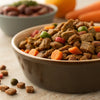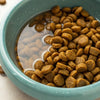Can Dogs Eat Cat Dry Food? Understanding the Risks and Recommendations
- Houndsy
Table of Contents
- Introduction
- Understanding Pet Nutrition
- What Happens If Your Dog Eats Cat Food?
- Managing Multi-Pet Households
- Conclusion
Introduction
As pet owners, we often find ourselves in amusing situations, like watching our dog stealthily inch toward the cat’s food bowl. It's a scene familiar to many of us, evoking laughter and perhaps a hint of frustration. But this raises an important question: can dogs eat cat dry food? While it might seem harmless if your dog sneaks a few kibbles, the reality is more complex.
In this blog post, we will explore the nutritional differences between dog and cat food, the potential risks associated with dogs consuming cat food, and practical solutions for managing multi-pet households. By the end of this article, you’ll have a thorough understanding of why cat food isn't a suitable long-term option for dogs, and how to ensure your furry friends receive the nutrition they need without any mishaps.
We invite you to reflect on your own feeding routines: Are you prepared to navigate the challenges of feeding both dogs and cats? Let’s dive into this topic and uncover what you need to know to keep your pets healthy and happy.
Understanding Pet Nutrition
Dog vs. Cat Food: The Nutritional Divide
The first step in addressing whether dogs can eat cat food is to understand the fundamental differences between dog and cat nutrition.
- Protein and Fat Content: Cat food typically contains higher levels of protein and fat compared to dog food. For instance, adult cat food often has a minimum of 26% protein and 9% fat, whereas dog food contains about 18% protein and 5.5% fat. This is because cats are obligate carnivores, meaning their diets must primarily consist of meat. Dogs, on the other hand, are omnivores, requiring a more balanced diet that includes carbohydrates and vegetables.
- Essential Nutrients: Cats require certain nutrients, such as taurine and arachidonic acid, which are not essential for dogs. Taurine, for example, is a vital amino acid for cats that aids in heart function, vision, and reproduction. Dogs can synthesize these nutrients from other food sources.
- Vitamins and Minerals: The vitamin and mineral requirements also differ significantly. While dogs need a variety of vitamins, cats require higher levels of certain nutrients like Vitamin A and B vitamins. Dog food often lacks these essential components in the quantities needed by cats.
The Implications of Feeding Cats and Dogs Together
When dogs consume cat food, they're often exposed to excessive amounts of protein and fat. While a small amount might not cause immediate harm, regular consumption can lead to a range of health issues.
- Gastrointestinal Upset: Dogs that indulge in cat food may experience vomiting, diarrhea, or abdominal discomfort. This is particularly true for dogs with sensitive stomachs or those not accustomed to high-fat diets.
- Obesity: The higher calorie concentration in cat food can contribute to weight gain in dogs, especially if they are already predisposed to obesity. Over time, this can lead to serious health complications.
- Pancreatitis: One of the more severe risks is pancreatitis, an inflammation of the pancreas that can occur in dogs consuming high-fat foods. Symptoms can include lethargy, vomiting, abdominal pain, and loss of appetite.
What Happens If Your Dog Eats Cat Food?
Occasional Snacking vs. Regular Consumption
If your dog sneaks a few bites of cat food, it may not be a cause for alarm. However, if it becomes a regular occurrence, it’s essential to monitor your dog's health closely.
- Short-Term Effects: In the short term, your dog might exhibit mild gastrointestinal upset. If this happens, it's usually advisable to withhold food for a meal or two to allow their stomach to settle.
- Long-Term Risks: Prolonged exposure to cat food can lead to more severe health issues such as obesity and pancreatitis, as discussed earlier.
What To Do If Your Dog Eats Cat Food
If you catch your dog indulging in cat food, here are some steps you can take:
- Monitor Their Behavior: Keep an eye on your dog for any signs of discomfort or distress over the next 24 hours. Look for symptoms like vomiting, diarrhea, or lethargy.
- Hydration is Key: Ensure your dog has access to fresh water. Hydration can help mitigate some digestive upset.
- Contact Your Veterinarian: If your dog exhibits severe symptoms or you have concerns about their health, don’t hesitate to reach out to your veterinarian for advice.
A Personal Story
Let’s consider the experience of a friend of ours, Sarah, who has both a dog named Max and a cat named Bella. One day, she noticed Max sneaking into Bella’s food bowl and devouring her cat food. After a week of this behavior, Max began to exhibit signs of discomfort—frequent whining and an upset stomach. Sarah decided to consult her vet, who explained the risks associated with Max’s new diet. They discussed transitioning Max back to his dog food and ensuring that Bella’s food was placed in an area where Max couldn’t reach it.
Managing Multi-Pet Households
Having both dogs and cats can be rewarding, but it can also present unique challenges, especially concerning feeding. Here are some strategies to create harmony during mealtime:
Feeding Separately
- Designated Feeding Areas: Set up separate feeding stations for your dog and cat in different rooms. This reduces the temptation for your dog to steal from the cat’s bowl.
- Scheduled Meal Times: Feed your pets at the same time, but in separate spaces. This can help establish a routine and minimize sneaky snacks.
- Elevated Feeding Solutions: Consider elevated feeding stations for your cat that are out of reach of your dog. This can be as simple as placing the cat's food on a high shelf or using a cat tree.
Using Feeding Tools
- Automatic Feeders: Investing in automatic feeders can help manage portion control and ensure that each pet gets their designated meal without interference.
- Microchip Feeders: These feeders only open for the specific pet wearing an RFID collar tag, ensuring that only your cat can access her food.
Conclusion
In conclusion, while it may seem harmless for dogs to eat cat dry food occasionally, it is not a recommended practice due to the significant nutritional differences between the two. Regularly feeding your dog cat food can lead to health complications, including gastrointestinal issues, obesity, and pancreatitis.
As responsible pet owners, we must prioritize our pets' nutritional needs by providing them with suitable food. If you’re managing a household with both dogs and cats, consider implementing strategies such as designated feeding areas and automatic feeders to prevent any mishaps.
Reflecting on our own feeding routines can lead to healthier choices for our furry family members. If you’re looking to enhance your pet feeding experience, we encourage you to explore the Houndsy Kibble Dispenser. This innovative solution not only simplifies feeding but also ensures your dog receives the proper portions every time.
FAQ
Can dogs eat cat food occasionally?
Yes, while a small amount of cat food may not harm your dog, it is not advisable to feed them cat food regularly due to the nutritional imbalance.
What should I do if my dog eats a lot of cat food?
Monitor them for any signs of discomfort, ensure they stay hydrated, and consult your veterinarian if symptoms persist.
Why is cat food bad for dogs?
Cat food is higher in protein and fat, which can lead to obesity, gastrointestinal upset, and pancreatitis in dogs.
Can my dog get sick from eating cat food?
Yes, dogs can experience gastrointestinal issues and other health problems if they consume cat food regularly.
How can I prevent my dog from eating my cat's food?
Feed your pets in separate areas, consider elevated feeding solutions for your cat, and invest in automatic or microchip feeders.












